| It has been suggested that this article be merged into List of Roman emperors. (Discuss) Proposed since December 2024. |
| Emperor and Autocrat of the Romans | |
|---|---|
| Imperial | |
 Last to reign Last to reignConstantine XI 6 January 1449 – 29 May 1453 | |
| Details | |
| First monarch | Constantine I |
| Last monarch | Constantine XI |
| Formation | 11 May 330 |
| Abolition | 29 May 1453 |
| Residence | Great Palace, Blachernae Palace |
| Appointer | Unspecified, de facto hereditary |
| Pretender(s) | None |
The foundation of Constantinople in 330 AD marks the conventional start of the Eastern Roman Empire, which fell to the Ottoman Empire in 1453 AD. Only the emperors who were recognized as legitimate rulers and exercised sovereign authority are included, to the exclusion of junior co-emperors (symbasileis) who never attained the status of sole or senior ruler, as well as of the various usurpers or rebels who claimed the imperial title.
The following list starts with Constantine the Great, the first Christian emperor, who rebuilt the city of Byzantium as an imperial capital, Constantinople, and who was regarded by the later emperors as the model ruler. Modern historians distinguish this later phase of the Roman Empire as Byzantine due to the imperial seat moving from Rome to Byzantium, the Empire's integration of Christianity, and the predominance of Greek instead of Latin.
The Byzantine Empire was the direct legal continuation of the eastern half of the Roman Empire following the division of the Roman Empire in 395. Emperors listed below up to Theodosius I in 395 were sole or joint rulers of the entire Roman Empire. The Western Roman Empire continued until 476. Byzantine emperors considered themselves to be Roman emperors in direct succession from Augustus; the term "Byzantine" became convention in Western historiography in the 19th century. The use of the title "Roman Emperor" by those ruling from Constantinople was not contested until after the papal coronation of the Frankish Charlemagne as Holy Roman emperor (25 December 800).
The title of all Emperors preceding Heraclius was officially "Augustus", although other titles such as Dominus were also used. Their names were preceded by Imperator Caesar and followed by Augustus. Following Heraclius, the title commonly became the Greek Basileus (Gr. Βασιλεύς), which had formerly meant sovereign, though Augustus continued to be used in a reduced capacity. Following the establishment of the rival Holy Roman Empire in Western Europe, the title "Autokrator" (Gr. Αὐτοκράτωρ) was increasingly used. In later centuries, the Emperor could be referred to by Western Christians as the "Emperor of the Greeks". Towards the end of the Empire, the standard imperial formula of the Byzantine ruler was " in Christ, Emperor and Autocrat of the Romans" (cf. Ῥωμαῖοι and Rûm).
Dynasties were a common tradition and structure for rulers and government systems in the Medieval period. The principle or formal requirement for hereditary succession was not a part of the Empire's governance; hereditary succession was a custom and tradition, carried on as habit and benefited from some sense of legitimacy, but not as a "rule" or inviolable requirement for office at the time.
Constantinian dynasty (306–363)
Main article: Constantinian dynasty (#) – Ambiguous legitimacy| Portrait | Name | Reign | Notes |
|---|---|---|---|

|
Constantine I "the Great" Flavius Valerius Constantinus |
25 July 306 – 22 May 337 (30 years, 9 months and 27 days) West; then whole |
Born at Naissus c. 272 as the son of the Augustus Constantius and Helena. Proclaimed Augustus of the western empire upon the death of his father on 25 July 306, he became sole ruler of the western empire after the Battle of the Milvian Bridge in 312. In 324, he defeated the eastern Augustus Licinius and re-united the empire under his rule, reigning as sole emperor until his death. Constantine completed the administrative and military reforms begun under Diocletian, who had begun ushering in the Dominate period. Actively interested in Christianity, he played a crucial role in its development and the Christianization of the Roman world, through his convocation of the First Ecumenical Council at Nicaea. He is said to have received baptism on his deathbed. He also reformed coinage through the introduction of the gold solidus, and initiated a large-scale building program, crowned by the re-foundation the city of Byzantium as "New Rome", popularly known as Constantinople. He was regarded as the model of all subsequent Byzantine emperors. His reign was marked by greater imperial control over the Eastern Church and the construction of new churches, especially at the holy places sacred to Christianity. To this day, Constantine is venerated as a saint by the eastern Orthodox church. |

|
Constantius II Flavius Julius Constantius |
9 September 337 – 3 November 361 (24 years, 1 month and 25 days) East; then whole |
Born on 7 August 317, as the second surviving son of Constantine I, he inherited the eastern third of Roman Empire upon his father's death, sole Roman Emperor from 353, after the overthrow of the western usurper Magnentius; after two years on the run, the latter committed suicide. Constantius' reign saw military activity on all frontiers, and dissension between Arianism, favoured by the emperor, and the "Orthodox" supporters of the Nicene Creed. In his reign, Constantinople was accorded equal status to Rome, and the original Hagia Sophia was built. Constantius appointed Constantius Gallus and Julian as Caesares, and died on his way to confront Julian, who had risen up against him. |

|
Julian "the Apostate" Flavius Claudius Julianus |
3 November 361 – 26 June 363 (1 year, 7 months and 23 days) |
Born in May 332 at Constantinople (the first emperor born there), Julian was the grandson of Constantius Chlorus and cousin of Constantius II. Proclaimed by his army in Gaul, he became the legitimate Emperor upon the death of Constantius. Julian has been described as the last pagan emperor of the Roman Empire and was generally opposed to Christianity. He was killed on campaign against Sassanid Persia, despite his initial success in surrounding the ancient city of Ctesiphon. For his adherence to the old Roman gods and rejection of the Christian faith, he became known as Julian the Apostate. |

|
Jovian Jovianus |
27 June 363 – 17 February 364 (7 months and 21 days) |
Born in c. 332, Jovian hailed from a military family and was captain of the guards (protector domesticus) under both Constantius II and Julian. He was elected by the army upon Julian's death. After assuming power, Jovian withdrew Roman forces from Persia and made an unpopular peace with them, which lasted until the early sixth-century. Following an autumn spent in Antioch, he died of natural causes in central Anatolia and was buried in Constantinople. |
Valentinianic dynasty (364–392)
Main article: Valentinianic dynasty (#) – Ambiguous legitimacy| Portrait | Name | Reign | Notes |
|---|---|---|---|

|
Valentinian I "the Great" Valentinianus |
25/26 February 364 – 17 November 375 (11 years, 8 months and 23 days) Whole; then West |
Born in 321. An officer under Julian and Jovian, he was elected by the army upon Jovian's death. He soon appointed his younger brother Valens as Emperor of the East, while he himself ruled in the West. Died of cerebral haemorrhage in 375. |

|
Valens | 28 March 364 – 9 August 378 (14 years, 4 months and 12 days; East) |
Born in 328, Valens was not especially fit for the imperial office if Ammianus can be believed, but he was appointed Emperor of the East in 364 by his elder brother Valentinian I, who wanted a malleable colleague in the other half of the Empire. Following Valentinians's death in 375, his son Gratian succeeded him. Meanwhile, Valens faced the challenge of the invading Huns, whose ferocity pushed the Gothic tribes to seek refuge within the Empire; Valens allowed them to settle on the condition that they become allies to the Empire. When the Goths were mistreated at Roman hands and rebelled, Valens proceeded to face them without awaiting assistance from Gratian's armies and was killed at the Battle of Adrianople. |

|
Procopius (#) | 28 September 365 – 27 May 366 (7 months and 29 days; East) |
Maternal cousin of Julian; revolted against Valens and captured Constantinople, where the people proclaimed him emperor. Deposed, captured and executed by Valens |
Theodosian dynasty (379–457)
Main article: Theodosian dynasty (#) – Ambiguous legitimacy| Portrait | Name | Reign | Notes | |
|---|---|---|---|---|
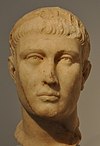
|
Theodosius I "the Great" |
19 January 379 – 17 January 395 (15 years, 11 months and 29 days) East; then whole |
Born on 11 January 347 in Spain, Theodosius was an aristocrat and military leader, and later brother-in-law of Gratian, who appointed him as emperor of the East in 379 and gave him charge of Macedonia and Dacia. During his reign, Theodosius made Orthodox Christianity the official religion of the state. He reunited the whole Empire after defeating Eugenius at the Battle of the Frigidus, in September 394. Theodosius died of a fever at Milan in 395 and his two sons, Honorius and Arcadius, became the emperors of the West and East, splitting power between them. | |

|
Arcadius | 17 January 395 – 1 May 408 (13 years, 3 months and 14 days; East) |
Born in 377/378, Arcadius was the eldest son of Theodosius I and upon the latter's death in 395, the Roman Empire was permanently divided between the Eastern Roman Empire—later referred to as the Byzantine Empire—and the Western Roman Empire with Arcadius becoming Byzantine emperor in the East while his younger brother Honorius became emperor in the West; both were manipulated by court officials and did not possess their father's leadership abilities. After contracting an illness, Arcadius died in 408.
| |

|
Theodosius II | 1 May 408 – 28 July 450 (42 years, 2 months and 27 days; East) |
Born on 10 April 401, he was the only son of Emperor Arcadius and Empress Aelia Eudoxia. Theodosius II succeeded the throne in 408 upon the death of his father. Because he was a minor, the praetorian prefect Anthemius was essentially regent from 408 to 414, but Theodosius II's elder sister Aelia Pulcheria played a critical role as regent and co-ruler during his early years. Pulcheria exerted considerable influence, shaping court policies and fostering Christian orthodoxy. Theodosius II was known for his mild and scholarly temperament. He had a keen interest in theology, astronomy, and calligraphy, and was reportedly well-educated, thanks to the influence of his sister Pulcheria. His long reign was marked by significant legal, administrative, and theological developments. One of the most enduring legacies of Theodosius II's reign was the construction of the Theodosian Walls of Constantinople. These massive fortifications protected the city for over a millennium and are regarded as one of the greatest defensive structures of antiquity. Theodosius II strongly supported Nicene Christianity and convened the Council of Ephesus in 431 CE, which declared the Virgin Mary as Theotokos ("God-bearer") and condemned the theology of Nestorianism. He also commissioned the Theodosian Code, a comprehensive compilation of Roman laws published in 438; this codex organized and systematized the legal framework of the empire and influenced later European legal traditions. During his reign, he faced constant threats from the Huns of Attila and negotiated treaties with the them, paying substantial tributes to prevent invasions. He married Aelia Eudocia Augusta, a learned woman of Greek descent, who, like the emperor's sister Pulcheria, became an influential figure in the court. Their marriage produced one daughter, Licinia Eudoxia, who later married Valentinian III, the Western Roman Emperor. Theodosius II died in 450 CE from injuries sustained after falling off his horse while hunting. His death marked the end of a relatively peaceful and prosperous reign, though it left unresolved issues such as rising threats from external enemies and religious divisions. | |

|
Marcian Marcianus |
25 August 450 – 27 January 457 (6 years, 5 months and 2 days; East) |
Born in 396. A soldier and politician, he became emperor after being wed by the Augusta Pulcheria, sister of Theodosius II, following the latter's death. Died of gangrene. | |
Leonid dynasty (457–518)
Main articles: Leonid dynasty and Byzantine Empire under the Leonid dynasty| Portrait | Name | Reign | Notes |
|---|---|---|---|

|
Leo I "the Butcher" | 7 February 457 – 18 January 474 (16 years, 11 months and 11 days) |
Born in Dacia c. 400, and of Bessian origin, Leo became a low-ranking officer and served as an attendant of the Gothic magister militum, Aspar, who chose him as emperor on Marcian's death. He was the first emperor to be crowned by the Patriarch of Constantinople, and the first one to legislate in Greek. His reign was marked by the pacification of the Danube and peace with Persia, which allowed him to intervene in the affairs of the West, supporting candidates for the throne and dispatching an expedition to recover Carthage from the Vandals in 468. Initially a puppet of Aspar, Leo began promoting the Isaurians as a counterweight to Aspar's Goths, marrying his daughter Ariadne to the Isaurian leader Tarasicodissa (Zeno). With their support, in 471 Aspar was murdered and Gothic power over the army was broken. |

|
Leo II "the Younger" | 18 January – November 474 (10 months) |
Born 468, he was the grandson of Leo I by Leo's daughter Ariadne and her Isaurian husband, Zeno. He was raised to Augustus on 17 November 473. Leo ascended the throne after the death of his grandfather on 18 January 474. He crowned his father as co-emperor and effective regent on 29 January, dying shortly after. |

|
Zeno | 29 January 474 – 9 January 475 (11 months and 11 days) |
Born c. 425 in Isauria, originally named Tarasicodissa. As the leader of Leo I's Isaurian soldiers, he rose to comes domesticorum, married the emperor's daughter Ariadne and took the name Zeno, and played a crucial role in the elimination of Aspar and his Goths. He was named co-emperor by his son on 29 January 474 and became sole ruler upon the latter's death, but had to flee to his native country before Basiliscus in 475, regaining control of the capital in 476. Zeno concluded peace with the Vandals, saw off challenges against him by Illus and Verina, and secured peace in the Balkans by enticing the Ostrogoths under Theodoric the Great to migrate to Italy where the Gothic king ruled. Convincing Theodoric to move his Goths westward into Italy allowed Zeno to reduce what had been a drain to imperial resources, since these Germanic warriors had been exacting payments from the Empire throughout the 470s and 480s and menacing Eastern territories. As a consequence, Zeno's reign also saw the end of the western line of emperors. His pro-Monophysite stance made him unpopular and his promulgation of the Henotikon resulted in the Acacian Schism with the papacy. |

|
Basiliscus | 9 January 475 – August 476 (1 year and 7 months) with Marcus (475–476) |
General and brother-in-law of Leo I, seized power from Zeno and crowned himself emperor on 12 January. Zeno was restored soon after. Died in 476/477 |

|
Zeno (second reign) |
August 476 – 9 April 491 (14 years and 8 months) |
Retook the throne with the help of general Illus. Saw the end of the Western Roman Empire. Died of dysentery or epilepsy |
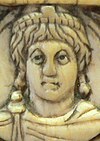
|
Anastasius I "Dicorus" | 11 April 491 – 9 July 518 (27 years, 2 months and 28 days) |
Born c. 430 at Dyrrhachium, Anastasius was a palace official (silentiarius) when he was chosen as the husband and ultimately Emperor by Empress-dowager Ariadne. He was nicknamed "Dikoros" (Latin: Dicorus), because of his heterochromia. Apparently, there was some insistence from the citizenry of Constantinople that Zeno's successor was an Orthodox Christian, which caused Ariadne to turn to Anastasius in the first place. Anastasius reformed the tax system and the Byzantine coinage and proved a frugal ruler, so that by the end of his reign he left a substantial surplus. His Monophysite sympathies led to widespread opposition, most notably the Revolt of Vitalian and the Acacian Schism. His reign was also marked by the first Bulgar raids into the Balkans and by a war with Persia over the foundation of Dara. He died childless. Shortly before his death, he tried to devise a means for one of his three nephews to succeed him by placing a note that read Regnum under their beds, but when none of them chose that bed, he decided instead to name the first person he saw the following morning. Keeping true to his word, when Justin—commander of the imperial guards—entered his presence first that morning, he was pronounced as Anastasius's successor. |
Justinian dynasty (518–602)
Main article: Byzantine Empire under the Justinian dynasty| Portrait | Name | Reign | Notes | |
|---|---|---|---|---|

|
Justin I Justinus |
9/10 July 518 – 1 August 527 (9 years and 23 days) |
Born c. 450 at Bederiana (Justiniana Prima), Dardania. Officer and commander of the Excubitors bodyguard under Anastasius I, he was elected by army and people upon the death of Anastasius I. | |
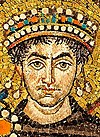
|
Justinian I "the Great" Petrus Sabbatius Justinianus |
1 April 527 – 14 November 565 (38 years, 7 months and 13 days) |
Born in 482/483 at Tauresium (Taor) Macedonia, Justinian was the nephew of Justin I and was made consul in 521; he was elevated to co-emperor on 1 April 527, when Justin fell ill. He succeeded Justin I's as emperor upon the former's death. Through his mighty commanding general Belisarius, Justinian was able to regain North Africa, as well as much of Italy and Spain; these were territories that had been seized and occupied previously by various Germanic tribes (Vandals and Goths) at the former Western Roman Empire's expense. He carried out a massive building program throughout the Empire, including construction of the famous Hagia Sophia at Constantinople. Justinian was also responsible for the corpus juris civilis, or the "body of civil law," which is the foundation of law for many modern European nations. | |

|
Justin II Justinus |
14 November 565 – 5 October 578 (12 years, 10 months and 21 days) |
Born c. 520. Nephew of Justinian I, he seized the throne on the death of Justinian I with support of army and Senate. Became insane, hence in 573–574 under the regency of his wife Sophia, and in 574–578 under the regency of Tiberius Constantine. | |

|
Tiberius II Constantine Tiberius Constantinus |
26 September 578 – 14 August 582 (3 years, 10 months and 19 days) |
Born c. 535, commander of the Excubitors, friend and adoptive son of Justin. Was named Caesar and regent in 574. Succeeded on Justin II's death. | |

|
Maurice Mauricius Tiberius |
13 August 582 – 27 November 602 (20 years, 3 months and 14 days) with Theodosius (590–602) |
Born in 539 at Arabissus, Cappadocia. Maurice became an official and later a general of the Byzantine army in the East under Tiberius II, achieving notable successes against the Sassanian Empire during the Byzantine–Sassanian War of 572–591. He married the daughter of Tiberius II and was proclaimed emperor on 13 August 582 after Tiberius II's death. Maurice fought wars against the Sassanian kingdom on the eastern front of his empire, the Avars and Slavs for control over the Balkans, and reinforced Byzantine holdings in Ravenna and Carthage. He is best remembered for his contributions to Byzantine military theory, notably his treatise Strategikon, a manual on warfare. Maurice named his son Theodosius as co-emperor in 590. Deposed by a centurion named Phocas, he was captured and executed on 27 November 602 along with his family at Chalcedon. | |

|
Phocas Focas |
23 November 602 – 5 October 610 (7 years, 10 months and 12 days) |
Subaltern in the Balkan army, he led a rebellion that deposed Maurice. Increasingly unpopular and tyrannical, he was deposed and executed by Heraclius. | |
Heraclian dynasty (610–695)
Main article: Byzantine Empire under the Heraclian dynasty| Portrait | Name | Reign | Notes |
|---|---|---|---|

|
Heraclius Ἡράκλειος |
5 October 610 – 11 February 641 (30 years, 4 months and 6 days) |
Born c. 575 as the eldest son of the Exarch of Africa, Heraclius the Elder. Began a revolt against Phocas in 609 and deposed him in October 610. Brought the Byzantine-Sassanid War of 602–628 to successful conclusion but was unable to stop the Muslim conquest of Syria. Heraclius' officials worked to replace Latin with Greek as the official language of administration in the East. By this time Latin had long fallen out of everyday use in the Eastern part of the Empire and Heraclius's adopting of the title basileus (king or emperor) "marked a shift from Rome towards a Greek and Eastern Christian culture." |

|
Heraclius Constantine (Constantine III) Heraclius Constantinus Ἡράκλειος Κωνσταντῖνος |
11 February – 25 May 641 (3 months and 14 days) |
Born on 3 May 612 as the eldest son of Heraclius by his first wife Fabia Eudokia. Named co-emperor on 22 January 613, he succeeded to throne with his younger brother Heraklonas following the death of Heraclius. Died of tuberculosis, allegedly poisoned by Empress-dowager Martina. |

|
Heraclonas Heraclius, Ἡράκλειος |
25 May – 5 November (?) 641 (5 months and 11 days) with Tiberius-David, son of Heraclius (641) |
Born in 626 to Heraclius' second wife Martina, named co-emperor on 4 July 638. Succeeded to throne with Constantine III following the death of Heraclius. Sole emperor after the death of Constantine III, under the regency of Martina, but was forced to name Constans II co-emperor by the army, and was deposed by the Senate in September 641 (or early 642). |

|
Constans II "the Bearded" Constantinus, Κωνσταντῖνος |
September 641 – 15 July 668 (26 years and 10 months) |
Born on 7 November 630, Constans II was the son of Constantine III. Raised to co-emperor in summer 641 after his father's death due to army pressure, he became sole emperor after the forced abdication of his uncle Heracleonas and his exile. Baptized Heraclius, he reigned as Constantin but was given the nickname "Constans". He faced a number of Arab incursions, almost losing his life while commanding the Byzantine fleet. Constans had some military success against the Slavs in the Balkans. Around 662, he moved his seat and court to Syracuse, intending to liberate Italy from the Lombards. His presence was unwelcome in Italy and there was "fierce opposition" to Constans II's abandonment of Constantinople. He was assassinated by a chamberlain in 668. |

|
Constantine IV Constantinus, Κωνσταντῖνος |
September 668 – 10 July (?) 685 (16 years and 10 months) with Heraclius and Tiberius, sons of Constans II (659–681) |
Born in 652, co-emperor since 13 April 654, he succeeded following the murder of his father Constans II. Erroneously called "Constantine the Bearded" by historians through confusion with his father. He called the Third Council of Constantinople which condemned the heresy of Monothelitism, repelled the First Arab Siege of Constantinople, and died of dysentery. |

|
Justinian II "Rhinotmetus" Justinianus, Ἰουστινιανός |
July 685 – 695 (10 years) |
Born in 669, son of Constantine IV, he was named co-emperor in 681 and became sole emperor upon Constantine IV's death. Deposed by military revolt in 695, mutilated (hence his surname) and exiled to Cherson, whence he recovered his throne in 705. |
Twenty Years' Anarchy (695–717)
Main article: Twenty Years' Anarchy| Portrait | Name | Reign | Notes |
|---|---|---|---|

|
Leontius Λέων(τιος) |
695 – 698 (3 years) |
General from Isauria, he deposed Justinian II and was overthrown in another revolt in 698. He was executed in February 706. |

|
Tiberius III Τιβέριος |
698 – 21 August (?) 705 (7 years) |
Admiral of Germanic origin, originally named Apsimar. He rebelled against Leontius after a failed expedition. Reigned under the name of Tiberius until deposed by Justinian II in 705. Executed in February 706. |

|
Justinian II "Rhinotmetus" Justinianus, Ἰουστινιανός (second reign) |
21 August (?) 705 – 4 November 711 (6 years, 2 months and 14 days) with Tiberius, son of Justinian II (706–711) |
Returned on the throne with Bulgar support. Named son Tiberius as co-emperor in 706. Deposed and killed by military revolt. |

|
Philippicus Filepicus, Φιλιππικός |
4 November 711 – 3 June 713 (1 year, 6 months and 30 days) |
A general of Armenian origin, he deposed Justinian II and was in turn overthrown by a revolt of the Opsician troops. |

|
Anastasius II Artemius Anastasius Ἀρτέμιος Ἀναστάσιος |
4 June 713 – fall 715 (less than 2 years) |
Originally named Artemios. A bureaucrat and secretary under Philippicus, he was raised to the purple by the soldiers who overthrew Philippicus. Deposed by another military revolt, he led an abortive attempt to regain the throne in 718 and was killed. |

|
Theodosius III Θεοδόσιος |
Fall 715 – 25 March 717 (less than 2 years) |
A fiscal official, he was proclaimed emperor by the rebellious Opsician troops. Entered Constantinople in November 715. Abdicated following the revolt of Leo the Isaurian and became a monk. |
Isaurian (Syrian) dynasty (717–802)
Main article: Byzantine Empire under the Isaurian dynasty (#) – Ambiguous legitimacy| Portrait | Name | Reign | Notes |
|---|---|---|---|

|
Leo III "the Isaurian" Λέων |
25 March 717 – 18 June 741 (24 years, 2 months and 24 days) |
Born c. 685 in Germanikeia, Commagene, he became a general. Rose in rebellion and secured the throne in spring 717. Repelled the Second Arab Siege of Constantinople and initiated the Byzantine Iconoclasm. |

|
Constantine V "Copronymus" Κωνσταντῖνος |
18 June 741 – 14 September 775 (34 years, 2 months and 27 days) |
Born in July 718, the only son of Leo III. Co-emperor since 720, he succeeded upon his father's death. After overcoming the usurpation of Artabasdos, he continued his father's iconoclastic policies and won several victories against the Arabs and the Bulgars. He is given the surname "the Dung-named" by hostile later chroniclers. |

|
Artabasdos (#) Ἀρτάβασδος |
June 741 – 2 November 743 (2 years and 5 months) with Nikephoros, son of Artabasdos (741–743) |
General and son-in-law of Leo III, Count of the Opsician Theme. Led a revolt that secured Constantinople, but was defeated and deposed by Constantine V, who blinded and tonsured him. |

|
Leo IV "the Khazar" Λέων |
14 September 775 – 8 September 780 (4 years, 11 months and 25 days) |
Born on 25 January 750 as the eldest son of Constantine V. Co-emperor since 751, he succeeded upon his father's death. |

|
Constantine VI Κωνσταντῖνος |
8 September 780 – 19 August 797 (16 years, 11 months and 11 days) |
Born in 771, the only child of Leo IV. Co-emperor since 14 April 776, sole emperor upon Leo's death in 780, until 790 under the regency of his mother, Irene of Athens. He was overthrown on Irene's orders, blinded and imprisoned, probably dying of his wounds shortly after. |

|
Irene Εἰρήνη |
19 August 797 – 31 October 802 (5 years, 2 months and 12 days) |
Born c. 752 in Athens, she married Leo IV on 3 November 768 and was crowned empress on 17 December. Regent for her son Constantine VI in 780–790, she dethroned and blinded him in 797 and became empress-regnant. In 787 she called the Second Council of Nicaea which condemned the practice of iconoclasm and restored the veneration of icons to Christian practice. Deposed in a palace coup in 802, she was exiled and died on 9 August 803. |
Nikephorian dynasty (802–813)
Main article: Byzantine Empire under the Nikephorian dynasty| Portrait | Name | Reign | Notes | |
|---|---|---|---|---|

|
Nikephoros I "the Logothete" Νικηφόρος |
31 October 802 – 26 July 811 (8 years, 8 months and 26 days) |
Logothetes tou genikou (general finance minister) under Irene, led initially successful campaigns against the Bulgars but was killed at the Battle of Pliska. | |

|
Staurakios Σταυράκιος |
28 July – 2 October 811 (2 months and 4 days) |
Only son of Nikephoros I, crowned co-emperor in December 803. Succeeded on his father's death; however, he had been heavily wounded at Pliska and left paralyzed. He was forced to abdicate, and retired to a monastery where he died soon after. | |
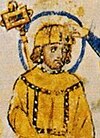
|
Michael I Rangabe Μιχαὴλ |
2 October 811 – 11 July 813 (1 year, 9 months and 9 days) with Theophylact and Staurakios, sons of Michael I (811–813) |
Son-in-law of Nikephoros I, he succeeded Staurakios on his abdication. Resigned after the revolt under Leo the Armenian and retired to a monastery, where he died on 11 January 844. Reigned with eldest son Theophylact as co-emperor. | |

|
Leo V "the Armenian" Λέων |
11 July 813 – 25 December 820 (7 years, 5 months and 14 days) with Constantine Symbatios (813–820) |
General of Armenian origin, born c. 755. He rebelled against Michael I and became emperor. Appointed his son Symbatios co-emperor under the name of Constantine in 813. Revived Byzantine Iconoclasm. Murdered by a conspiracy led by Michael the Amorian. | |
Amorian dynasty (820–867)
Main article: Byzantine Empire under the Amorian dynasty (§) – Varying ascribed status| Portrait | Name | Reign | Notes |
|---|---|---|---|

|
Michael II "the Amorian" Μιχαὴλ |
25 December 820 – 2 October 829 (8 years, 9 months and 7 days) |
Born in 770 at Amorium, he became an army officer. A friend of Leo V, he was raised to high office but led the conspiracy that murdered him. He was sentenced to execution by Leo, but was proclaimed emperor by Leo's assassins and crowned by Patriarch Theodotus I on the same day. He survived the rebellion of Thomas the Slav, lost Crete to the Arabs, faced the beginning of the Muslim conquest of Sicily, and reinforced iconoclasm. |

|
Theophilos Θεόφιλος |
2 October 829 – 20 January 842 (12 years, 3 months and 18 days) with Constantine (c. 834–835) |
Born in 813 as the only son of Michael II. Crowned co-emperor on 12 May 821, he succeeded on his father's death. |

|
Theodora (§) Θεοδώρα |
20 January 842 – 15 March 856 (14 years, 1 month and 24 days) with Thekla (842–856) |
Widow of Theophilos, she was a ruler in her own right during the minority of their son Michael III, who deposed her in 856. Died of natural causes |

|
Michael III "the Drunkard" Μιχαὴλ |
20 January 842 – 24 September 867 (25 years, 8 months and 4 days) |
His precise date of birth is uncertain, but the balance of available evidence supports a birthdate in January 840. The son of Theophilos, he succeeded on Theophilos' death. Under the regency of his mother Theodora until 856, and under the effective control of his uncle Bardas in 862–866. Ended iconoclasm. Murdered by Basil the Macedonian. A pleasure-loving ruler, he was nicknamed "the Drunkard" by later, pro-Basil chroniclers. |
Macedonian dynasty (867–1056)
Main articles: Macedonian dynasty, Lekapenos, and Byzantine Empire under the Macedonian dynasty| Portrait | Name | Reign | Notes | |
|---|---|---|---|---|
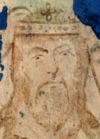
|
Basil I "the Macedonian" Βασίλειος |
24 September 867 – 29 August 886 (18 years, 11 months and 5 days) with Constantine (868–879) |
Born in the Theme of Macedonia c. 811, he rose in prominence through palace service, becoming a favourite of Michael III, who crowned him co-emperor on 26 May 866. He overthrew Michael and established the Macedonian dynasty. He led successful wars in the East against the Arabs and the Paulicians, and recovered southern Italy for the Empire. | |
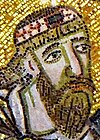
|
Leo VI "the Wise" Λέων |
29 August 886 – 11 May 912 (25 years, 8 months and 12 days) |
Born on 19 September 866, either the legitimate son of Basil I or the illegitimate son of Michael III. Co-emperor since 6 January 870. Leo was known for his erudition. His reign saw a height in Saracen (Muslim) naval raids, culminating in the Sack of Thessalonica, and was marked by unsuccessful wars against the Bulgarians under Simeon I. | |

|
Alexander Αλέξανδρος |
11 May 912 – 6 June 913 (1 year and 26 days) |
Son of Basil I, Alexander was born in 870 and raised to co-emperor in 879. Sidelined by Leo VI, Alexander dismissed his brother's principal aides on his accession. Died of illness, possibly testicular cancer | |

|
Constantine VII Porphyrogenitus Κωνσταντῖνος |
6 June 913 – 9 November 959 (46 years, 5 months and 3 days) |
Son of Leo VI, he was born on 17/18 May 905 and raised to co-emperor on 15 May 908. His early reign was dominated by successive regencies, first by his mother, Zoe Karbonopsina, and Patriarch Nicholas Mystikos, and from 919 by the admiral Romanos Lekapenos, who wedded his daughter to Constantine and was crowned senior emperor in 920. Constantine re-asserted his control by deposing Romanos's sons on 27 January 945. His reign was marked by struggles with Sayf al-Dawla in the East and an unsuccessful campaign against Crete, and pro-aristocratic policies that saw a partial reversal of Lekapenos' legislation against the dynatoi. He is notable for his promotion of the "Macedonian Renaissance", sponsoring encyclopaedic works and histories. He was a prolific writer himself, best remembered for the manuals on statecraft (De administrando imperio) and ceremonies (De ceremoniis) he compiled for his son. | |
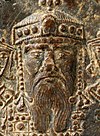
|
Romanos I Lekapenos Ῥωμανὸς |
17 December 920 – 20 December 944 (24 years and 3 days) with Christopher (921–931), Stephen and Constantine Lekapenos (924–945) |
An admiral of lowly origin, Romanos rose to power as a protector of the young Constantine VII against the general Leo Phokas the Elder. He became emperor in 920. His reign was marked by the end of warfare with Bulgaria and the great conquests of John Kourkouas in the East. Romanos promoted his sons Stephen and Constantine (alongside Christopher, who died soon after) as co-emperors over Constantine VII, but was himself overthrown by them and confined to an island as a monk. He died there on 15 June 948. | |

|
Romanos II Ῥωμανὸς |
9 November 959 – 15 March 963 (3 years, 4 months and 6 days) |
The only surviving son of Constantine VII, he was born on 15 March 938 and succeeded his father on the latter's death. He ruled until his own death, although the government was led mostly by the eunuch Joseph Bringas. His reign was marked by successful warfare in the East against Sayf al-Dawla and the recovery of Crete by general Nikephoros Phokas. | |
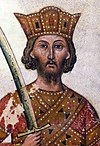
|
Nikephoros II Phokas Νικηφόρος |
16 August 963 – 11 December 969 (6 years, 3 months and 25 days) |
The most successful general of his generation, Nikephoros II was born c. 912 to the powerful Phokas clan. After the death of Romanos II, he rose to the throne with the support of the army and people as regent for the young emperors Basil II and Constantine VIII, marrying the empress-dowager Theophano. Throughout his reign he led campaigns in the East, conquering much of Syria. He was murdered by his nephew and one-time associate John Tzimiskes. | |

|
John I Tzimiskes Ἰωάννης |
11 December 969 – 10 January 976 (6 years and 30 days) |
Nephew of Nikephoros Phokas, Tzimiskes was born c. 925. A successful general, he fell out with his uncle and led a conspiracy of disgruntled generals who murdered him. Tzimiskes succeeded Nikephoros as emperor and regent for the young sons of Romanos II. As ruler, Tzimiskes crushed the Rus' in Bulgaria and ended the Bulgarian tsardom before going on to campaign in the East, where he died. | |
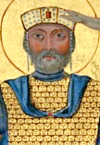
|
Basil II "the Bulgar-Slayer" Βασίλειος |
10 January 976 – 15 December 1025 (49 years, 11 months and 5 days) |
Eldest son of Romanos II, Basil II was born in 958 to Romanus II. The first decade of his reign was marked by rivalry with the powerful Basil Lekapenos, an unsuccessful war against Bulgaria, and rebellions by generals in Asia Minor. Basil solidified his position through a marriage alliance of his sister Anna to Vladimir I of Kiev, which was accompanied by the conversion to Christian Orthodoxy of the grand Kievian Rus' prince and his people. After over 20 years of war, Basil eventually succeeded in his conquest of Bulgaria, which was finally subdued in 1018, earning him the name "Bulgar-slayer." His conquest of Bulgar was periodically interrupted by warfare in Syria against the Fatimid Caliphate. Basil expanded Byzantine control over most of Armenia and his reign is widely considered as the apogee of medieval Byzantium. | |
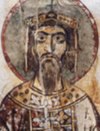
|
Constantine VIII Κωνσταντῖνος |
15 December 1025 – 12 November 1028 (2 years, 10 months and 28 days) |
The second son of Romanos II, Constantine was born in 960 and raised to co-emperor on 30 March 962. During the rule of Basil II, he spent his time in idle pleasure. During his short reign he was an indifferent ruler, easily influenced by his courtiers and suspicious of plots to depose him, especially among the military aristocracy, many of whom were blinded and exiled. | |

|
Romanos III Argyros Ῥωμανὸς |
12 November 1028 – 11 April 1034 (5 years, 4 months and 30 days) |
Born in 968, the elderly aristocrat Romanos—who had served in both the judiciary and civil service—was chosen by Constantine VIII on his deathbed, after being required to marry the emperor's daughter Zoe under the alternative threat of being blinded and sent to a monastery. Romanos III succeeded to the throne upon Constantine's death a few days later. Deluded by grandeur, Romanos fashioned himself at one time as a philosopher king like Marcus Aurelius and later as a military genius like Trajan, resulting in military debacles. He initiated expensive church building projects. A subsequent affair between his wife Zoe and his chief eunuch's brother Michael, led to the pair colluding in poisoning Romanos, before ultimately resolving to having the emperor strangled and drowned in his own bath. | |

|
Michael IV "the Paphlagonian" Μιχαὴλ |
12 April 1034 – 10 December 1041 (7 years, 7 months and 28 days) |
Born in 1010, he became a lover of Zoe even while Romanos III was alive, and succeeded him upon his death as her husband and emperor. Aided by his older brother, the eunuch John the Orphanotrophos, his reign was moderately successful against internal rebellions, but his attempt to recover Sicily failed. He died after a long illness. | |

|
Michael V "Kalaphates" Μιχαὴλ |
13 December 1041 – 21 April 1042 (4 months and 8 days) |
Born in 1015, he was the nephew and adopted son of Michael IV. During his reign he tried to sideline Zoe, but a popular revolt forced him to restore her as empress on 19 April 1042, along with her sister Theodora. He was deposed the next day, castrated and tonsured, dying on 24 August 1042. | |

|
Zoë Porphyrogenita Ζωή |
21 April – 11 June 1042 (1 month and 21 days) |
The daughter of Constantine VIII, she succeeded on her father's death, as the only surviving member of the Macedonian dynasty, along with her sister Theodora. Her three husbands, Romanos III (1028–1034), Michael IV (1034–1041) and Constantine IX (1042–1050) ruled alongside her. | |

|
Theodora Porphyrogenita Θεοδώρα |
21 April – 11 June 1042 (1 month and 21 days) |
The younger sister of Zoe, born in 984, she was raised as co-ruler on 19 April 1042. After Zoe married her third husband, Constantine IX, in June 1042, Theodora was again sidelined. After Zoe died in 1050 and Constantine in 1055, Theodora assumed full governance of the Empire and reigned until her death. She nominated Michael VI as her successor. | |

|
Constantine IX Monomachos Κωνσταντῖνος Μονομάχος |
11 June 1042 – 11 January 1055 (12 years and 7 months) |
Born c. 1000 of noble origin, he had an undistinguished life but was exiled to Lesbos by Michael IV, returning when he was chosen as Zoe's third husband. Constantine supported the mercantile classes and favoured the company of intellectuals, thereby alienating the military aristocracy. A pleasure-loving ruler, he lived an extravagant life with his favourite mistresses and endowed a number of monasteries, chiefly the Nea Moni of Chios and the Mangana Monastery. His reign was marked by invasions by the Pechenegs in the Balkans and the Seljuk Turks in the East, the revolts of George Maniakes and Leo Tornikios, and the Great Schism between the patriarchates of Rome and Constantinople. | |

|
Theodora Porphyrogenita Θεοδώρα (second reign) |
11 January 1055 – 31 August 1056 (1 year, 7 months and 20 days) |
Claimed the throne again after Constantine IX's death as the last living member of the Macedonian dynasty. Died of natural causes | |

|
Michael VI Bringas "Stratiotikos" Μιχαήλ |
22 August 1056 – 30 August 1057 (1 year and 8 days) |
A court bureaucrat and stratiotikos logothetes (hence his first sobriquet). Proclaimed emperor by Theodora on her deathbed on 22 August 1056. Deposed by military revolt under Isaac Komnenos, he retired to a monastery where he died in 1059. | |

|
Isaac I Komnenos Ἰσαάκιος Κομνηνός |
1 September 1057 – 22 November 1059 (2 years, 2 months and 21 days) |
Born c. 1005. A successful general, he rose in revolt leading the eastern armies and was declared emperor on 8 June 1057; he was recognized after the abdication of Michael. He resigned in 1059 and died c. 1061. | |
Doukas dynasty (1059–1078)
Main articles: Doukas and Byzantine Empire under the Doukas dynasty (§) – Varying ascribed status| Portrait | Name | Reign | Succession | Life details |
|---|---|---|---|---|

|
Constantine X Doukas Κωνσταντῖνος Δούκας |
23 November 1059 – 23 May 1067 (7 years and 6 months) |
Designated as emperor by Isaac I Komnenos during his abdication | c. 1006 – 23 May 1067 (aged approx. 61) Lost nearly all Italian territories to the Normans. Died of natural causes |

|
Eudokia Makrembolitissa Εὐδοκία Μακρεμβολίτισσα (§) |
23 May – 31 December 1067 (7 months and 8 days) |
Widow of Constantine X; ruler in her own right on behalf of their sons until her marriage to Romanos IV. Briefly resumed her regency in September 1071 | c. 1030 – after 1078 Became a nun in November 1071 and later died of natural causes |

|
Romanos IV Diogenes Ῥωμανὸς Διογένης |
1 January 1068 – 26 August 1071 (3 years, 7 months and 25 days) with Leo and Nikephoros Diogenes (c. 1070–71) |
Husband of Eudokia. Regent and senior co-emperor together with Constantine X's and Eudokia's children | c. 1032 – 4 August 1072 (aged approx. 40) Captured at Manzikert by the Seljuk Turks. After his release blinded on 29 June 1072 by John Doukas, later dying of his wounds |

|
Michael VII Doukas "Parapinakes" Μιχαὴλ Δούκας |
1 October 1071 – 24/31 March 1078 (6 years, 5 months and 23/30 days) with Konstantios (1060–1078), Andronikos (1068–1070s) and Constantine Doukas (1074–78; 1st time) |
Son of Constantine X; made co-emperor in 1060 with Eudokia and Romanos IV. Proclaimed sole emperor after Romanos' defeat at the Battle of Manzikert | c. 1050 – c. 1090 (aged approx. 40) Lost nearly all of Anatolia to the Turks. Forced to become a monk after a popular uprising. Died of natural causes several years later |

|
Nikephoros III Botaneiates Νικηφόρος Βοτανειάτης |
3 April 1078 – 1 April 1081 (2 years, 11 months and 29 days) |
General; revolted against Michael VII on 2 July or 2 October 1077 and entered Constantinople on 27 March or 3 April. Married Maria of Alania, the former wife of Michael VII | 1001/1002 – c. 1081 (aged approx. 80) Abdicated after Alexios I captured Constantinople, became a monk and died of natural causes, probably later in the same year |
Komnenos dynasty (1081–1185)
Main articles: Komnenos and Byzantine Empire under the Komnenos dynasty| Portrait | Name | Reign | Succession | Life details |
|---|---|---|---|---|

|
Alexios I Komnenos Ἀλέξιος Κομνηνός |
1 April 1081 – 15 August 1118 (37 years, 4 months and 14 days) with Constantine Doukas (1081–1087; 2nd time) |
Nephew of Isaac I, also husband of Irene Doukaina, a grand-niece of Constantine X. General; revolted against Nikephoros III on 14 February 1081. Seized Constantinople on 1 April; crowned on 4 April | c. 1057 – 15 August 1118 (aged approx. 61) Started the Crusades & the reconquest of Anatolia. Died of natural causes |

|
John II Komnenos "the Good" Ἰωάννης Κομνηνός |
15 August 1118 – 8 April 1143 (24 years, 7 months and 24 days) with Alexios Komnenos, son of John II (1119–1142) |
Son of Alexios I, co-emperor since about September 1092 | 13 September 1087 – 8 April 1143 (aged 55) Reconquered most of Anatolia by the time of his death. Died of injuries sustained in a hunting accident, possibly assassinated (perhaps involving Raymond of Poitiers or supporters of Manuel I) |

|
Manuel I Komnenos "the Great" Μανουὴλ Κομνηνός |
8 April 1143 – 24 September 1180 (37 years, 5 months and 16 days) |
Youngest son and allegedly designated heir of John II on his deathbed, crowned in November 1143 after a few months of having to establish his rights | 28 November 1118 – 24 September 1180 (aged 61) Last emperor to attempt reconquests in the west. Died of natural causes |

|
Alexios II Komnenos Ἀλέξιος Κομνηνός |
24 September 1180 – c. September 1183 (3 years) |
Son of Manuel I; co-emperor since 1171 | 14 September 1169 – c. September 1183 (aged 14) Strangled on the orders of Andronikos I, body thrown in the sea |
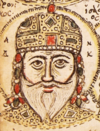
|
Andronikos I Komnenos "Misophaes" Ἀνδρόνικος Κομνηνός |
c. September 1183 – 12 September 1185 (2 years) with John Komnenos, son of Andronikos I (1183–1185) |
Son of Isaac Komnenos, a son of Alexios I. Overthrew the regency of Alexios II in April 1182, crowned co-emperor in 1183 and shortly thereafter had Alexios II murdered | c. 1118/1120 – 12 September 1185 (aged 64–67) Overthrown by Isaac II, tortured and mutilated in the imperial palace, then slowly dismembered alive by a mob in the Hippodrome |
Angelos dynasty (1185–1204)
Main articles: Angelos and Byzantine Empire under the Angelos dynasty| Portrait | Name | Reign | Succession | Life details |
|---|---|---|---|---|

|
Isaac II Angelos Ἰσαάκιος Κομνηνός Ἄγγελος |
12 September 1185 – 8 April 1195 (9 years, 6 months and 27 days) |
Great-grandson of Alexios I. Resisted an order of arrest issued by Andronikos I, after which he was proclaimed emperor by the people of Constantinople. Captured and killed Andronikos I | c. 1156 – January 1204 (aged 47) Suffered the loss of Bulgaria. Overthrown and blinded by Alexios III in 1195, reinstalled in 1203 |

|
Alexios III Angelos Ἀλέξιος Κομνηνός |
8 April 1195 – 17/18 July 1203 (8 years, 3 months and 10 days) |
Elder brother of Isaac II, overthrew and blinded his brother | c. 1156 – 1211/1212 (aged approx. 58) Fled after brief resistance against the Fourth Crusade. Died a natural death after being captured and forced to become a monk by Theodore I |
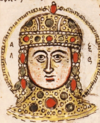
|
Alexios IV Angelos Ἀλέξιος Ἄγγελος |
19 July 1203 – 27 January 1204 (6 months and 8 days) |
Son of Isaac II, overthrew Alexios III with the help of the crusaders as part of the Fourth Crusade, then named co-emperor alongside his blinded father | c. 1182/1183 – c. 8 February 1204 (aged approx. 21) Deposed and imprisoned by Alexios V, then strangled in prison |

|
Isaac II Angelos Ἰσαάκιος Κομνηνός Ἄγγελος (second reign) |
19 July 1203 – 27 January 1204 (6 months and 8 days) |
Freed from imprisonment during the Fourth Crusade by courtiers and reinstated as ruler after Alexios III abandoned the defense of Constantinople | c. 1156 – January 1204 (aged 47) Became senile or demented and died of natural causes shortly before Alexios V's coup |

|
Alexios V Doukas "Mourtzouphlos" Ἀλέξιος Δούκας |
27/28 January – 12 April 1204 (2 months and 16 days) |
Seized power through a palace coup, son-in-law of Alexios III. | c. 1139 – c. late November 1204 (aged approx. 65) Fled during the sack of Constantinople. Blinded by Alexios III, later captured by crusader Thierry de Loos and thrown from the Column of Theodosius |
Laskaris dynasty (1205–1261)
Main articles: Laskaris and Empire of Nicaea- Note: Roman rule in Constantinople was interrupted with the capture and sack of the city by the crusaders in 1204, which led to the establishment of the Frankokratia. Though the crusaders created a new line of Latin emperors in the city, modern historians recognize the line of emperors of the Laskaris dynasty, reigning in Nicaea, as the legitimate Roman emperors during the struggle for Constantinople because the Nicene Empire eventually retook the city. For other lines of claimant emperors, see List of Trapezuntine emperors and List of Thessalonian emperors.
| Portrait | Name | Reign | Succession | Life details |
|---|---|---|---|---|

|
Theodore I Laskaris Θεόδωρος Κομνηνὸς Λάσκαρις |
c. May 1205 – November 1221 (16 years and 6 months) with Nicholas Laskaris (1208–1210) |
Husband of Anna Komnene Angelina, a daughter of Alexios III. Organized resistance against the Latin Empire in Nicaea and proclaimed emperor in 1205 after the Battle of Adrianople; crowned by Patriarch Michael IV on 6 April 1208. | c. 1174 – November 1221 (aged approx. 47) Died of natural causes |

|
John III Vatatzes Ἰωάννης Δούκας Βατάτζης |
c. December 1221 – 3 November 1254 (32 years and 11 months) |
Husband of Irene Laskarina, a daughter of Theodore I | c. 1192 – 3 November 1254 (aged approx. 62) Started Nicaean expansionism. Died of natural causes |

|
Theodore II Laskaris Θεόδωρος Δούκας Λάσκαρις |
3 November 1254 – 16 August 1258 (3 years, 9 months and 13 days) |
Son of John III and grandson of Theodore I, co-emperor since about 1235 | November 1221 – 16 August 1258 (aged 36) Died of epilepsy |

|
John IV Laskaris Ἰωάννης Δούκας Λάσκαρις |
16 August 1258 – 25 December 1261 (3 years, 4 months and 9 days) |
Son and co-emperor of Theodore II | 25 December 1250 – c. 1305 (aged approx. 55) Blinded, deposed and imprisoned by Michael VIII Palaiologos in 1261, died in captivity several decades later |
Palaiologos dynasty (1259–1453)
Main articles: Palaiologos and Byzantine Empire under the Palaiologos dynasty| Portrait | Name | Reign | Succession | Life details |
|---|---|---|---|---|
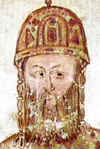
|
Michael VIII Palaiologos Μιχαὴλ Δούκας Ἄγγελος Κομνηνὸς Παλαιολόγος |
1 January 1259 – 11 December 1282 (23 years, 11 months and 10 days) |
Great-grandson of Alexios III; became regent for John IV in 1258 and crowned co-emperor in 1259. Regained Constantinople on 25 July 1261, entered the city on 15 August. Became sole ruler after deposing John IV on 25 December | 1224/1225 – 11 December 1282 (aged 57/58) Died of dysentery |

|
Andronikos II Palaiologos Ἀνδρόνικος Δούκας Ἄγγελος Κομνηνὸς Παλαιολόγος |
11 December 1282 – 24 May 1328 (45 years, 5 months and 13 days) |
Son of Michael VIII; named co-emperor shortly after 1261, crowned on 8 November 1272 | 25 March 1259 – 13 February 1332 (aged 72) Deposed by his grandson Andronikos III in 1328 and became a monk, dying of natural causes four years later |

|
Michael IX Palaiologos (§) Μιχαὴλ Δούκας Ἄγγελος Κομνηνὸς Παλαιολόγος |
21 May 1294 – 12 October 1320 (26 years, 4 months and 21 days) |
Son and co-ruler of Andronikos II, named co-emperor in 1281, crowned on 21 May 1294 | 17 April 1277/1278 – 12 October 1320 (aged 42/43) Allegedly died of grief due to the accidental murder of his second son, probably died of natural causes |
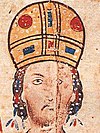
|
Andronikos III Palaiologos Ἀνδρόνικος Δούκας Ἄγγελος Κομνηνός Παλαιολόγος |
24 May 1328 – 15 June 1341 (13 years and 22 days) |
Son of Michael IX, named co-emperor between 1308 and 1313. Fought with his grandfather Andronikos II for power from April 1321 onwards. Crowned emperor on 2 February 1325, became sole emperor after deposing Andronikos II | 25 March 1297 – 15 June 1341 (aged 44) Last Emperor to effectively control Greece. Died of sudden illness, possibly malaria |
| John V Palaiologos Ίωάννης Κομνηνός Παλαιολόγος |
15 June 1341 – 16 February 1391 (49 years, 8 months and 1 day) Details
|
Son of Andronikos III, not formally crowned until 19 November 1341. Dominated by regents until 1354, faced numerous usurpations and civil wars throughout his long reign | 18 June 1332 – 16 February 1391 (aged 58) Reigned almost 50 years, but only held effective power for 33. Lost almost all territories outside Constantinople. Died of natural causes | |

|
John VI Kantakouzenos Ἰωάννης Ἄγγελος Κομνηνὸς Παλαιολόγος Καντακουζηνός |
8 February 1347 – 10 December 1354 (7 years, 10 months and 2 days) with Matthew Kantakouzenos (1353–1357) |
Related to the Palaiologoi through his mother. Proclaimed by the army on 26 October 1341, became regent and senior co-emperor after a lengthy civil war with John V's mother, Anna of Savoy. Entered Constantinople on 8 February, crowned on 21 May 1347 | c. 1295 – 15 June 1383 (aged approx. 88) Deposed by John V in another civil war and retired, becoming a monk. Died of natural causes several decades later |

|
Andronikos IV Palaiologos Ἀνδρόνικος Κομνηνός Παλαιολόγος |
12 August 1376 – 1 July 1379 (2 years, 10 months and 19 days) May 1381 – June 1385 (4 years, in Selymbria) |
Son of John V and grandson of John VI; named co-emperor and heir in 1352, but imprisoned and partially blinded after a failed rebellion in May 1373. Rebelled again and successfully deposed his father in 1376; not formally crowned until 18 October 1377 | 11 April 1348 – 25/28 June 1385 (aged 37) Deposed by John V in 1379; fled to Galata in exile but was restored as co-emperor and heir in May 1381, ruling over Selymbria and the coast of Marmara. Rebelled again in June 1385 but died shortly thereafter |
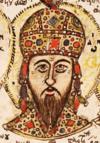
|
John VII Palaiologos Ίωάννης Παλαιολόγος |
14 April – 17 September 1390 (5 months and 3 days) late 1403 – 22 September 1408 (5 years, in Thessalonica) with Andronikos V Palaiologos (1403–1407) |
Son of Andronikos IV, co-emperor since 1377; usurped the throne from John V in 1390. Deposed shortly thereafter but granted Thessalonica by Manuel II in 1403, from where he once more ruled as emperor until his death | 1370 – 22 September 1408 (aged 38) Ruled Constantinople as regent in 1399–1403 during Manuel II's absence. Died of natural causes |
| Manuel II Palaiologos Μανουὴλ Παλαιολόγος |
16 February 1391 – 21 July 1425 (34 years, 4 months and 5 days) |
Son of John V and grandson of John VI; co-emperor since 25 September 1373 | 27 June 1350 – 21 July 1425 (aged 74) Suffered a stroke in 1422, whereafter the government was run by his son, John VIII. Died of natural causes | |
| John VIII Palaiologos Ίωάννης Παλαιολόγος |
21 July 1425 – 31 October 1448 (23 years, 4 months and 10 days) |
Son of Manuel II; co-emperor by 1407 and full emperor since 19 January 1421 | 18 December 1392 – 31 October 1448 (aged 55) Died of natural causes | |

|
Constantine XI Palaiologos Κωνσταντῖνος Δραγάσης Παλαιολόγος |
6 January 1449 – 29 May 1453 (4 years, 4 months and 23 days) |
Son of Manuel II and favored successor of his brother John VIII. Crowned emperor in Mystras on 6 January 1449, entered Constantinople on 12 March. | 8 February 1405 – 29 May 1453 (aged 48) The last Roman emperor. Died in battle at the fall of Constantinople. |
See also
- Family tree of Byzantine emperors
- List of Roman emperors
- List of Trapezuntine emperors
- List of Roman usurpers
- List of Byzantine usurpers
- Succession to the Byzantine Empire
- List of Roman and Byzantine empresses
- List of Byzantine emperors of Armenian origin
- Family tree of Roman emperors
- History of the Byzantine Empire
References
Notes
- Historian Donald Nicol writes, "Hereditary succession to the throne was a custom or a convenience in Byzantium, not an inviolable... principle. Emperors, particularly in the later period, would take pains to nominate their sons as co-emperors, for the rule of a dynasty made for stability and continuity. But in theory, the road to the throne was a carriere ouverte aux talents ..."
- ^ Unless otherwise noted to be some other ambiguity, the emperors marked to be of ambiguous legitimacy are those who fulfill one or more of the inclusion criteria above, but who are not universally regarded by scholars to count as legitimate. In most cases, such figures are those who held power only briefly, and/or who in times of more than one emperor held one of the capitals but never achieved the full recognition of the other emperor(s).
- From the fourth century, emperors and other high-profile men of non-aristocratic birth often bore the name "Flavius", the family name of the Constantinian dynasty. Because it was often used as a status marker rather than personal name, "Flavius" will generally be omitted in the following entries for simplicity.
- Distinction between nomen, praenomen and cognomen, the core elements of Roman naming conventions, began to fade away from the 3rd century onwards. Given that "new Romans" —that is, barbarians turned citizens— adopted the names of their masters, many citizens adopted the names Julius, Flavius (notable the Constantinians) and Marcus Aurelius (notable the 3rd century emperors), thus making them obsolete as surnames. As a result, most citizens of the Empire, even emperors, reverted back to single-names by the 5th century.
- While some historians attribute the division of the Roman Empire into East and West after Theodosius the Great split the throne between his sons, the year 364 probably more accurately marks the point at which the Empire was actually divided.
- ^ Although they constitutionally held the same supreme power as their senior counterpart, it is customary among scholars of the later empire to only regard those who actually ruled as emperors, omitting junior co-emperors who only exercised power nominally and never governed in their own name.
- From 629 onwards, Heraclius issued administrative documents in Greek. Latin continued to be used in communication with Western Europe until the end of the empire and coins continued to be struck with Latin inscriptions until the early eighth century.
- Heraclius Constantine is often enumerated as 'Constantine III', though this name is also often applied to the earlier western emperor and has also been used for Heraclius Constantine's son Constans II (who actually ruled under the name 'Constantine', 'Constans' being a nickname).
- Latin ceased being used in coin inscriptions under Leo III.
- ^ The empresses marked as being of "varying ascribed status" are figures who were undisputed as legitimate heads of the imperial government and who are sometimes (including by the Oxford Dictionary of Byzantium), though not always, seen as having been empresses regnant.
- ^ Emperors began to officially use family names from Constantine IX Monomachos onwards. The sole exception after Constantine IX's reign is Michael VI, whose family name (Bringas) was far less distinguished than those of the other imperial families and thus does not appear in official use.
- Unattested in coinage; Leo is only called emperor in a singular letter, while his brother's status can only be deduced from the fact that he was born in the purple and that he also used the "imperial tokens".
- Alexios III used the name Alexios Komnenos Angelos (Ἀλέξιος Κομνηνός Ἄγγελος) prior to his accession but reigned as Alexios Komnenos, dropping his own family name in order to stress his matrilineal descent from the Komnenos dynasty.
Citations
- ^ Nicol 1993, p. 72.
- Hooker 2007.
- Morrisson 2013, p. 72.
- Karayannopoulous 2000, p. 183.
- Vagi 1999, pp. 415, 463, 529.
- Omissi 2018, p. 24.
- Seibt 2018, p. 213.
- Tilemachos 2015, p. 243.
- Gregory, Timothy E.; Cutler, Anthony (1991). "Constantine I the Great". In Kazhdan, Alexander (ed.). The Oxford Dictionary of Byzantium. Oxford and New York: Oxford University Press. pp. 498–500. ISBN 0-19-504652-8.
- Lygo 2022, pp. 25–26.
- Pohlsander 1996, pp. 92–93.
- Lygo 2022, p. 28.
- Gregory, Timothy E. (1991). "Constantius II". In Kazhdan, Alexander (ed.). The Oxford Dictionary of Byzantium. Oxford and New York: Oxford University Press. p. 524. ISBN 0-19-504652-8.
- Lygo 2022, p. 30.
- Lygo 2022, pp. 30–31.
- Lygo 2022, p. 33.
- Cameron 1988, pp. 26, 28, 33.
- Elton 2018, p. 119.
- ^ Elton 2018, p. 120.
- Salway 1994.
- Lee 2013, pp. 21–22.
- Lee 2013, p. 23.
- Morgan 2007, pp. 42–43.
- Morgan 2007, pp. 43–45.
- PLRE, Vol. I, pp. 742–743; Kienast, Eck & Heil, p. 318.
- Mitchell 2015, p. 90.
- Lygo 2022, p. 42.
- Mitchell 2015, p. 94.
- Lygo 2022, p. 45.
- Lygo 2022, pp. 45–46.
- Lygo 2022, pp. 47–48.
- Kulikowski 2019, pp. 156–158.
- Lygo 2022, p. 50.
- Mitchell 2015, pp. 315–316.
- Kulikowski 2019, pp. 177–179.
- Kulikowski 2019, pp. 179–181.
- Kulikowski 2019, pp. 181–182, 184–186.
- Mitchell 2015, pp. 104, 107–108.
- Stephenson 2022, p. 162.
- Wickham 2009, p. 90.
- Gregory, Timothy E.; Cutler, Anthony (1991). "Leo I". In Kazhdan, Alexander (ed.). The Oxford Dictionary of Byzantium. Oxford and New York: Oxford University Press. pp. 1206–1207. ISBN 0-19-504652-8.
- Lygo 2022, p. 62.
- Lee 2013, p. 165.
- Gregory, Timothy E. (1991). "Zeno". In Kazhdan, Alexander (ed.). The Oxford Dictionary of Byzantium. Oxford and New York: Oxford University Press. p. 2223. ISBN 0-19-504652-8.
- Foss 2005, p. 101.
- ODB, p. 360.
- PLRE, Vol. II, pp. 1200–1202; ODB, p. 2223; Grant, pp. 327–329; Croke 2004, p. 572.
- Ostrogorski 1969, p. 59.
- Lygo 2022, pp. 66–67.
- Gregory, Timothy E. (1991). "Anastasios I". In Kazhdan, Alexander (ed.). The Oxford Dictionary of Byzantium. Oxford and New York: Oxford University Press. ISBN 0-19-504652-8.
- Lygo 2022, p. 67.
- Lygo 2022, p. 73.
- Kaldellis 2024, pp. 276–277.
- Sarris 2023, pp. 122–124.
- Stephenson 2022, pp. 103, 222–223.
- Stephenson 2022, pp. 223–224.
- Stephenson 2022, pp. 224–232.
- Stephenson 2022, p. 225.
- Stephenson 2022, pp. 231, 236–238.
- Kaegi 2003, p. 194.
- ^ Grierson 1973, p. 177.
- Norwich 1989, p. 311. sfn error: no target: CITEREFNorwich1989 (help)
- Lygo 2022, p. 98.
- PLRE, Vol. IIIA, p. 349; Grierson 1973, p. 385; Treadgold 1997, p. 308ff; Kaegi 2003, p. 112ff.
- Foss 2005, pp. 93–94.
- Louth 2008, p. 230. sfn error: no target: CITEREFLouth2008 (help)
- Louth 2008, pp. 230–231. sfn error: no target: CITEREFLouth2008 (help)
- Louth 2008, p. 232. sfn error: no target: CITEREFLouth2008 (help)
- ODB, pp. 739, 2037.
- ODB, pp. 56–57; Treadgold 1997, p. 471; Grierson 1973, p. 473–476.
- Kazhdan, Alexander; Cutler, Anthony (1991). "Constantine VII Porphyrogennetos". In Kazhdan, Alexander (ed.). The Oxford Dictionary of Byzantium. Oxford and New York: Oxford University Press. pp. 502–503. ISBN 0-19-504652-8.
- Gregory 2005, pp. 228–230. sfn error: no target: CITEREFGregory2005 (help)
- Lygo 2022, pp. 178–180.
- Morgan 2007, p. 91.
- Morgan 2007, pp. 92–93.
- Morgan 2007, pp. 93–94.
- Skylitzes 2010, p. 28. sfn error: no target: CITEREFSkylitzes2010 (help)
- Brand, Charles M.; Cutler, Anthony (1991). "Constantine VIII". In Kazhdan, Alexander (ed.). The Oxford Dictionary of Byzantium. Oxford and New York: Oxford University Press. pp. 503–504. ISBN 0-19-504652-8.
- Lygo 2022, p. 199.
- Lygo 2022, pp. 199–201.
- Grierson 1973, p. 180.
- Brand, Charles M.; Cutler, Anthony (1991). "Constantine IX Monomachos". In Kazhdan, Alexander (ed.). The Oxford Dictionary of Byzantium. Oxford and New York: Oxford University Press. p. 504. ISBN 0-19-504652-8.
- ODB, p. 2038; Treadgold 1997, pp. 491, 590.
- ODB, pp. 504–505; Schreiner, pp. 151–152; Grierson 1973, p. 764.
- ODB, pp. 739–740; Treadgold 1997, p. 608; Grierson 1973, pp. 779–780.
- PmbZ, Leon 15005..
- ODB, p. 1807; Treadgold 1997, pp. 601–604, 608; Schreiner, p. 156.
- ODB, pp. 1366–1367; Schreiner, p. 157–159; Norwich 1993, p. 361.
- ODB, p. 1479; Schreiner, p. 158–159; Grierson 1973, p. 798–799, 821; Maynard 2021.
- ODB, p. 63; Schreiner, p. 159–164.
- ODB, pp. 1046–1047; Treadgold 1997, pp. 628–637; Bucossi & Rodriguez Suarez 2016, p. 16.
- ODB, pp. 1289–1290; Treadgold 1997, pp. 636, 638–650.
- ODB, pp. 64, 1289; Treadgold 1997, pp. 650–653; Schreiner, p. 176.
- ODB, pp. 64, 94, 1012; Treadgold 1997, pp. 653–656; Lascaratos 1999, p. 73.
- ^ ODB, p. 1012; Treadgold 1997, pp. 654–660; Schreiner, pp. 183–185; Macrides 1999, VI: p. 75, X: p. 514, XII: p. 195.
- Cotsonis 2020, pp. 260–261.
- ODB, pp. 64–65; Treadgold 1997, pp. 659–664; Schreiner, pp. 183–185.
- ODB, pp. 65–66; Schreiner, pp. 183–185.
- ODB, p. 66; Treadgold 1997, pp. 265–266, 665; Schreiner, pp. 185–186.
- Treadgold 1997, p. 734.
- ODB, pp. 2039–2040; Angelov 2019, p. 18; Dragon 2003, p. 275.
- ODB, pp. 1047–1048; Angelov 2019, p. 256.
- ODB, pp. 2040–2041; Treadgold 1997, p. 731; Angelov 2019, p. 61, 258, 325.
- ODB, pp. 1048–1049; Macrides 2013, p. 303; Angelov 2019, p. 305; PLP, p. 2663 (#14534).
- ODB, p. 1367; Treadgold 1997, p. 745; Schreiner, pp. 196–206; PLP, p. 3929 (#21528).
- ODB, pp. 94–95; Angelov 2009, p. 100; PLP, p. 3889 (#21436).
- ODB, pp. 1367–8; Treadgold 1997, p. 755; Angelov 2009, p. 100; PLP, p. 3931 (#21529).
- ODB, p. 95; Treadgold 1997, p. 764; Lascaratos & Marketos 1997, pp. 106–9; PLP, p. 3891 (#21437).
- ODB, p. 1050; Schreiner, pp. 253, 345; PLP, p. 3912 (#21485).
- ODB, pp. 1050–1051; Schreiner, pp. 252–288; PLP, p. 2046 (#10973); Feiller 1976.
- ODB, p. 95; Mladenov 2003, p. 190; Schreiner, pp. 312–321; PLP, p. 3893 (#21438).
- ODB, p. 1052; Oikonomides 1977, p. 331; Schreiner, pp. 340–343; PLP, p. 3908 (#21480).
- ODB, p. 1291; Schreiner, pp. 276, 309, 429; PLP, p. 3923 (#21513).
- ODB, pp. 1053–1054; Schreiner, pp. 340, 387–411; PLP, p. 3909 (#21481).
- ODB, p. 505; Nicol 1992, pp. 2, 35–38, 70; PLP, p. 3919 (#21500).
Bibliography
- Angelov, Dimiter G. (2009). "Emperors and Patriarchs as Ideal Children and Adolescents: Literary Conventions and Cultural Expectations". In Papaconstantinou, Arietta; Talbot, Alice-Mary (eds.). Becoming Byzantine: Children and Childhood in Byzantium. Dumbarton Oaks. ISBN 978-0-8840-2356-2.
- Angelov, Dimiter (2019). The Byzantine Hellene: The Life of Emperor Theodore Laskaris and Byzantium in the Thirteenth Century. Cambridge: Cambridge University Press. ISBN 978-1-1084-8071-0.
- Bucossi, Alessandra; Rodriguez Suarez, Alex, eds. (2016). John II Komnenos, Emperor of Byzantium. London: Routledge. ISBN 978-1-4724-6024-0.
- Cameron, Alan (1988). "Flavius: a Nicety of Protocol". Latomus. 47 (1): 26–33. JSTOR 41540754.
- Cotsonis, John A. (2020). The Religious Figural Imagery of Byzantine Lead Seals I. Oxford: Routledge. ISBN 978-0-3673-4696-6.
- Croke, Brian (2004). "The Imperial Reigns of Leo II". Byzantinische Zeitschrift. 96 (2): 559–575. doi:10.1515/BYZS.2003.559. S2CID 191460505.
- Dragon, Gilbert (2003). Emperor and Priest: The Imperial Office in Byzantium. Cambridge University Press. ISBN 978-0-5218-0123-2.
- Elton, Hugh (2018). The Roman Empire in Late Antiquity: A Political and Military History. Cambridge and New York: Cambridge University Press. ISBN 978-1-10845-631-9.
- Feiller, Albert (1976). "Nouvelle note sur la chronologie du règne de Jean Cantacuzène" [New note on the chronology of the reign of John Kantakouzenos]. Études byzantines. 34: 119–124. doi:10.3406/rebyz.1976.2046.
- Foss, Clive (2005). "Emperors named Constantine". Revue numismatique. 6 (161): 93–102. doi:10.3406/numi.2005.2594.
- Garland, Lynda (1999). Byzantine Empresses: Women and Power in Byzantium AD 527–1204. London: Routledge. ISBN 0-4151-4688-7.
- Garland, Lynda (2006). Byzantine Women: Varieties of Experience 800–1200. Ashgate Publishing. ISBN 978-0-7546-5737-8.
- Grant, Michael (1985). The Roman Emperors: A Biographical Guide to the Rulers of Imperial Rome, 31 BC–AD 476. New York: Charles Scribner's Sons. ISBN 0-6841-8388-9.
- Grierson, Philip (1962). "The Tombs and Obits of the Byzantine Emperors (337–1042)". Dumbarton Oaks Papers. 16. doi:10.2307/1291157. JSTOR 1291157.
- Grierson, Philip (1968). Catalogue of the Byzantine Coins in the Dumbarton Oaks Collection and in the Whittemore Collection. Vol. 2. Dumbarton Oaks. ISBN 978-0-8840-2024-0.
- Grierson, Philip (1973). Catalogue of Byzantine Coins, vol. 3: Leo III to Nicephorus III, 717-1081. Washington D.C.: Dumbarton Oaks. ISBN 0-8840-2012-6.
- Hooker, Richard (2007). "European Middle Ages: The Byzantine Empire". Washington State University. Archived from the original on 24 February 1999. Retrieved 25 August 2015.
- Jones, A. H. M.; Martindale, J. R.; Morris, John, eds. (1971–1992). Prosopography of the Later Roman Empire. Cambridge: Cambridge University Press. (see PLRE)
- Kaegi, Walter E. (2003). Heraclius, Emperor of Byzantium. Cambridge: Cambridge University Press. ISBN 0-5218-1459-6.
- Kaldellis, Anthony (2024). The New Roman Empire: A History of Byzantium. Oxford and New York: Oxford University Press. ISBN 978-0-19754-932-2.
- Karayannopoulous, Yanis (2000). "State Organization, Social Structure, Economy, and Commerce". In M.A. Al-Bakhit; L. Bazin; S.M. Cissoko; M.S. Asimov (eds.). History of Humanity: Scientific and Cultural Development from the Seventh to the Sixteenth Centuries. Vol. IV. Paris: UNESCO. ISBN 978-9-23102-813-7.
- Kazhdan, Alexander, ed. (1991). Oxford Dictionary of Byzantium. Oxford: Oxford University Press. ISBN 978-0-1950-4652-6. (see ODB)
- Kienast, Dietmar; Werner Eck & Matthäus Heil (2017) . Römische Kaisertabelle: Grundzüge einer römischen Kaiserchronologie [Roman imperial table: Basics of the Roman imperial chronology] (in German) (6th ed.). Darmstadt: WBG. ISBN 978-3-5342-6724-8.
- Kulikowski, Michael (2019). The Tragedy of Empire: From Constantine to the Destruction of Roman Italy. Cambridge, MA: The Belknap Press of Harvard University Press. ISBN 978-0-67466-013-7.
- Lascaratos, J.; Marketos, S. (1997), "The fatal disease of the Byzantine Emperor Andronicus III Palaeologus (1328-1341 A.D.)", Journal of the Royal Society of Medicine, vol. 90, no. 2, pp. 106–109, doi:10.1177/014107689709000215, PMC 1296151, PMID 9068444
- Lascaratos, J. (1999). ""Eyes" on the Thrones: Imperial Ophthalmologic Nicknames". Survey of Ophthalmology. 44 (1): 73–78. doi:10.1016/S0039-6257(99)00039-9. ISSN 0039-6257. PMID 10466590.
- Lee, A.D. (2013). From Rome to Byzantium AD 363 to 565: The Transformation of Ancient Rome. Edinburgh: Edinburgh University Press. ISBN 978-0-74862-790-5.
- Lygo, Kevin (2022). The Emperors of Byzantium. London: Thames & Hudson. ISBN 978-0-50002-329-7.
- Macrides, Ruth (2013). Pseudo-Kodinos and the Constantinopolitan Court. Ashgate. ISBN 978-0-7546-6752-0.
- Macrides, Ruth (1999). Kinship and Justice in Byzantium, 11th–15th Centuries. Aldershot: Ashgate. ISBN 978-0-8607-8799-0.
- Maynard, Daniel R.F. (2021). "Nicephorus III". De Imperatoribus Romanis. Archived from the original on 11 March 2022.
- Mitchell, Stephen (2015). A History of the Later Roman Empire, AD 284–641 (2nd ed.). Oxford and Malden, MA: Wiley Blackwell. ISBN 978-1-11831-242-1.
- Mladenov, Momchil (2003). "John VII Palaiologos and the Bulgarian Lands in 1390". Journal Epohi (in Bulgarian). 11 (1): 189–196. ISSN 2534-8418.
- Morgan, Giles (2007). Byzantium. Harpenden: Pocket Essentials. ISBN 978-1-90404-883-1.
- Morrisson, Cécile (2013). "Displaying the Emperor's Authority and Kharaktèr on the Marketplace". In Pamela Armstrong (ed.). Authority in Byzantium. New York: Routledge. pp. 65–82. ISBN 978-1-40943-608-9.
- Nicol, Donald M. (1993). Last Centuries of Byzantium, 1261–1453. London: University of London. ISBN 978-0-52143-991-6.
- Nicol, Donald M. (1992). The Immortal Emperor: The Life and Legend of Constantine Palaiologos, Last Emperor of the Romans. Cambridge: Cambridge University Press. ISBN 978-0-511-58369-8.
- Norwich, John Julius (1993). Byzantium: The Apogee. Virginia: Penguin. ISBN 0-1401-1448-3.
- Oikonomides, Nicolas (1977). "John VII Palaeologus and the Ivory Pyxis at Dumbarton Oaks". Dumbarton Oaks Papers. 31: 329–337. doi:10.2307/1291411. JSTOR 1291411.
- Omissi, Adrastos (2018). Emperors and Usurpers in the Later Roman Empire. Oxford: Oxford University Press. ISBN 978-0-1988-2482-4.
- Ostrogorski, Georgije (1969). History of the Byzantine State. New Brunswick, NJ.: Rutgers University Press. OCLC 812752850.
- Pohlsander, Hans A. (1996). The Emperor Constantine. London and New York: Routledge. ISBN 0-203-34042-6.
- Lilie, Ralph-Johannes; et al. (2001–2016). Prosopography of the Byzantine World.
- Salway, Benet (1994). "What's in a Name? A Survey of Roman Onomastic Practice from c. 700 B.C. to A.D. 700". Journal of Roman Studies. 84: 137–140. doi:10.2307/300873. JSTOR 300873. S2CID 162435434.
- Sarris, Peter (2023). Justinian: Emperor, Soldier, Saint. New York: Basic Books. ISBN 978-0-213-76478-4.
- Schreiner, Peter (1977). Die byzantinischen Kleinchroniken II: Historischer Kommentar [Byzantine small chronicles 2: Historical commentary]. CFHB (in German). Vienna: ÖAW. ISBN 978-3-7001-0206-9.
- Seibt, Werner (2018). "Wer war Niketas Nobellisimos und Komes von Opsikion (8. Jahrhundert)?" [Who was Niketas Nobellisimos and Komes of Opsikion (8th century)?] (PDF). Jahrbuch der Österreichischen Byzantinistik (in German). 67: 213–216. doi:10.1553/joeb67s213.
- Stephenson, Paul (2022). New Rome: The Empire in the East. Cambridge, MA: The Belknap Press of Harvard University Press. ISBN 978-0-67465-962-9.
- Tilemachos, Lounghis (2015). "Review Article: Juan Signes Codoner, The emperor Theophilos and the East, 829-842: Court and frontier in Byzantium during the last phase of Iconoclasm, Birmingham Byzantine and Ottoman Studies, vol 13, Ashgate 2014". Byzantina Symmeikta. 25: 237–260. doi:10.12681/byzsym.8773.
- Trapp, Erich, ed. (2001). Prosopographisches Lexikon der Palaiologenzeit [Prosopographical Lexicon of the Palaiologan era] (in German). Vienna: ÖAW. ISBN 978-3-7001-1462-8. (see PLP)
- Treadgold, W. (1990). "A Note on Byzantium's Year of the Four Emperors". Byzantinische Zeitschrift. 83 (2): 431–33. doi:10.1515/byzs.1990.83.2.431. S2CID 194092611.
- Treadgold, Warren (1997). A History of the Byzantine State and Society. Stanford: Stanford University Press. ISBN 978-0-8047-2630-6.
- Vagi, David L. (1999). Coinage and History of the Roman Empire: c. 82 B.C. – A.D. 480. Volume I: History. London: Routledge. ISBN 978-1-1389-9907-7.
- Wickham, Chris (2009). The Inheritance of Rome: Illuminating the Dark Ages, 400–1000. Viking. ISBN 978-0-67002-098-0.
| Roman emperors by time period | |||||||||
|---|---|---|---|---|---|---|---|---|---|
| |||||||||
| Byzantine Empire topics | |||||||||||||||||||||||||||
|---|---|---|---|---|---|---|---|---|---|---|---|---|---|---|---|---|---|---|---|---|---|---|---|---|---|---|---|
| |||||||||||||||||||||||||||
| |||||||||||||||||||||||||||
| |||||||||||||||||||||||||||
| |||||||||||||||||||||||||||
| |||||||||||||||||||||||||||
| |||||||||||||||||||||||||||


